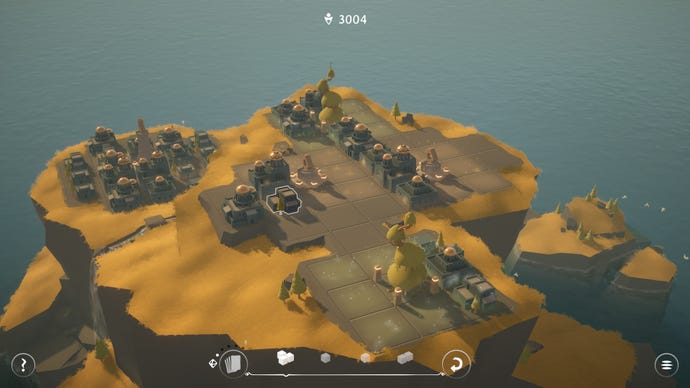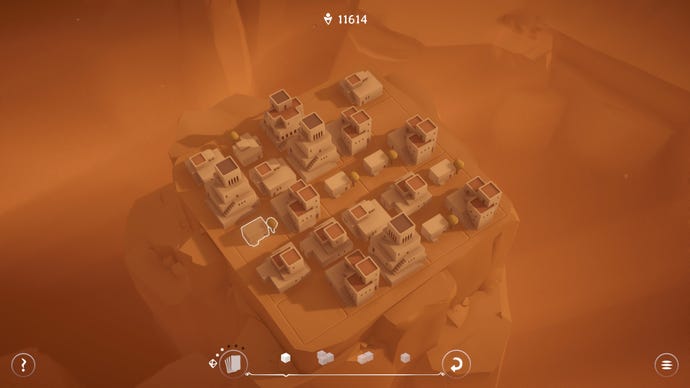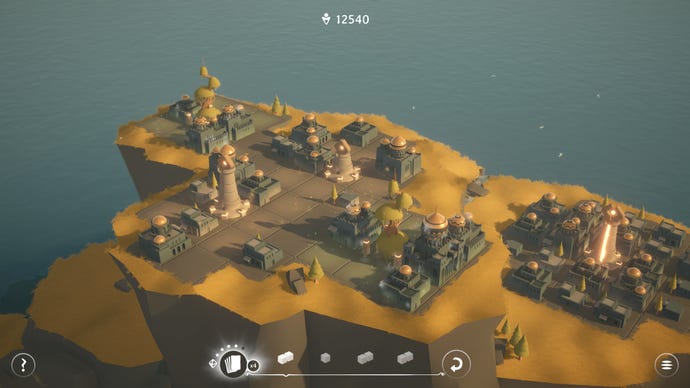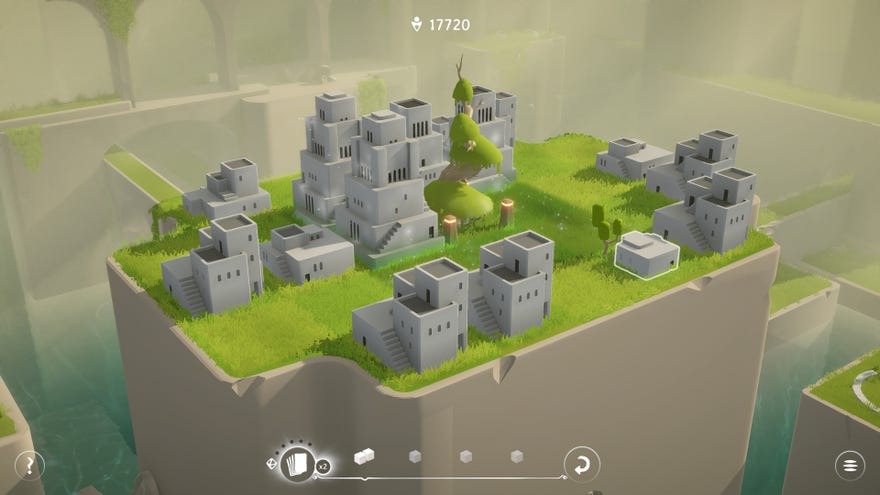Urbo review: Threes meets Dorfromantik in this chill puzzler
Sights in tight spaces
After busting down the castle door with their chaotic, siege-based citybuilder Diplomacy Is Not An Option last year, the last thing I expected to see next from developers Door 407 was a chill, meditative puzzle game that's just about, well, building tiny cities. In Urbo there are no sky lasers, no oncoming hordes. Nothing. Just dinky little grid-based maps, and an endless stream of tiny adorable buildings to plonk down on them in the pursuit of sweet, sweet point scores.
This being a puzzle game, the aim here is to place three buildings of the same type altogether, either in a line or right-angled cluster, at which point they'll all shzooge together to level up to the next building type. This is where the Threes comparison comes in, though you can zhuzh more than three of the same building together if you're smart to earn more points. But it's not quite as simple as that. You see, your buildings will only shoump onto the tile you placed down last, and careful city planners will likely want to think about placing their buildings in reverse so they end up with their fancy new house in the place they actually want it, not in an awkward middle spot that cuts off two precious tiles from play, or awkwardly sits in the middle of another chain of dwellings accidentally. And yep, that's where the Dorfromantik connection comes in, and I really do like it very, very much.




First released in September as a fun, relaxing game to occupy Door 407's playerbase while their development on Diplomacy Is Not An Option continued, Urbo is small, but perfectly formed. First you pick the setting of your town-to-be. You start with just the warm, orange hues of its simple Dunes, but as you reach higher and higher milestones with your point score, you'll gradually unlock the grassy, white stone cliffs of the Glade and Valley and the rippling coastlines of the Waterfall and Archipelago. Each board has its own unique shape and conditions, and working these out as you play is all part of the fun. Some might have special areas that double your score count, for example, while others have boards split between different locations. A couple of these dual-locations even have rules that play across both zones simultaneously, giving your brain plenty to chew on as you chase those high scores.

You can also choose your time of day - another cosmetic addition, but one that enhances Urbo's rich sense of atmosphere. I particularly love the soft shadows of the evening, and the golden light of the morning. Image credit: Rock Paper Shotgun/Door 407
You'll unlock more building types over time, too - though these are all purely cosmetic. Still, their respective toy-like designs scratch the same kind of dioramic itch that Dorfromantik does, just in a more contained space. You'll start a game and then wonder where the last two hours went, and I love how it saves your 'completed' towns on the menu screen so you can come back and admire them later. It's the kind of feature I wish Dorfromantik had when I first started playing it a couple of years ago, so it's great to have this kind of record of your creations right from the off.
It's also just quite fun and charming to imagine how the blocky, desert-oriented, flat-roofed Chimalma might look in a forest setting, for example, or how a Japanese-infused Satori settlement might have come into being in the mountainous, yellow grasslands of a coastal outcrop. Ultimately, this is quite a pure, nuts and bolts puzzle game at the end of the day, but that extra layer of presentation leaves more room in your imagination to project little stories onto them than, say, something like Threes does (and I love Threes' adorable little cards, but what can I say, I'm a sucker for cute, pastoral village scenes). Each building set has eight different levels to them as well, each one bigger and more grandiose than the last, and successfully thwomping them into their most majestic final forms not only gives each board a satisfying sense of height and variety, but it really does look like a lovely little hodge podge of a community, too.

Urbo has one extra trick to tax your strategy brain even further, too. Three might be the minimum number of buildings you need to level up, but if you can make it four or five, for example, you'll not only gain extra points, but you'll also gain cards that let you place other, fully formed buildings on the map from a random assortment of options. The run of the mill buildings you get in the endless stream, for instance, often only range between levels one to three most of the time, so playing a card to potentially plop down that final level five or six building you might need can be crucial. Some cards also let you swap buildings already on the map, or shunt an existing one to a spare tile. You never know what you're going to get, so choosing when the deploy these cards all becomes part of your overall puzzle strategy.
I did have one minor gripe when Urbo first launched, in that it was sometimes hard to discern the exact level of particular buildings, but a recent update has fixed this so you can always see exactly what's in play. So really, I have no complaints about this whatsoever. Neat! If I was being nitpicky, I'd still say that Dorf is probably the more nourishing puzzle game for me, what with its quests and discoveries and near-endless map sizes to play about in, but if you're more of a cerebral Threes-type, then Urbo will fit right into your regular puzzle regimen. It really is a lovely little thing, and a very chill way to while away a dark and rainy afternoon.
This review is based on a retail build of the game provided by developers Door 407.









